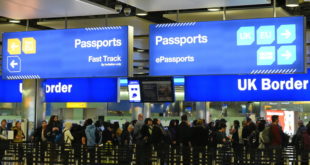Flight often have jet contrails–that is, the white vapor that follows the plane when it takes off.
But did you know these trails can tell you information about the weather?
Yesterday, I wrote about a team of pilots that used their contrails to make made an angel--which was pretty cool. But what does the usual contrail mean?
Did you know they could be used to predict the weather. A thin, shorter tail indicates low humidity and fair weather. A thick, longer lasting tail signifies the early indication of a storm.
The reason for this is Science. From Scientific America (apropos):
The hot, humid exhaust from jet engines mixes with the atmosphere, which at high altitude is of much lower vapor pressure and temperature than the exhaust gas. The water vapor contained in the jet exhaust condenses and may freeze, and this mixing process forms a cloud very similar to the one your hot breath makes on a cold day.
For some more specifics about how the weather affects the contrails, check out this article. It’s pretty cool!
 Le Chic Geek
Le Chic Geek





Informative! I did sometimes wonder as to what these trails meant. Not sure if it is also possible to guess the type of plane by looking at these vapors.
Sometimes the sky can be filled with some really pretty patterns which look especially cool in the sunset time of day.
Now just hope that you don’t have any “chem trails” nutjobs come by and post about their conspiracy theories!
This is potentially a fantastic and informative article. Like too many of its kind however, it’s factually inaccurate.
I won’t write a novel here, and to that end I’ll only point out one of the errors:
The airplanes mentioned above did’t use their contrails to make an image in the sky, they used airshow smoke.
The difference between the two is true science as well. A contrail is a “condensation trail,” where the disruption in the air by airplane (full explanation not given) causes the moisture in the air to condense, creating a little straight line cloud consisting of water vapor.
The trail you see behind a plane in an airshow is created when a small bit of a certain type of oil is injected in the exhaust of the aircraft, creating smoke.
Both trails are white, but that’s where the similarities end. You cannot determine the above weather state in the above example by using the smoke trail of an airplane involved in an airshow.
That part is right–they don’t use their contrails in air shows and I should have said smoke for that one, but the article itself is about the contrails generated on take off.